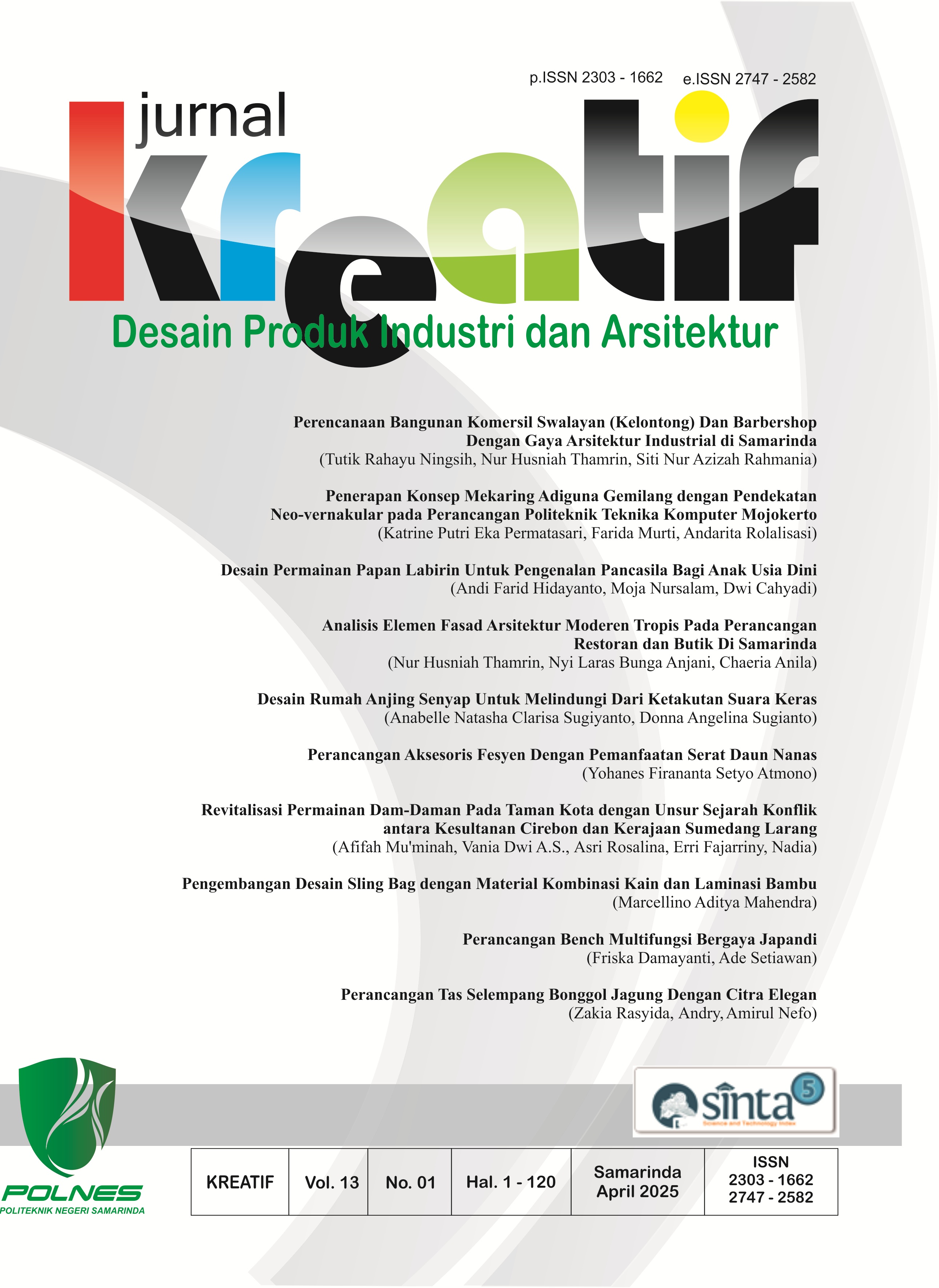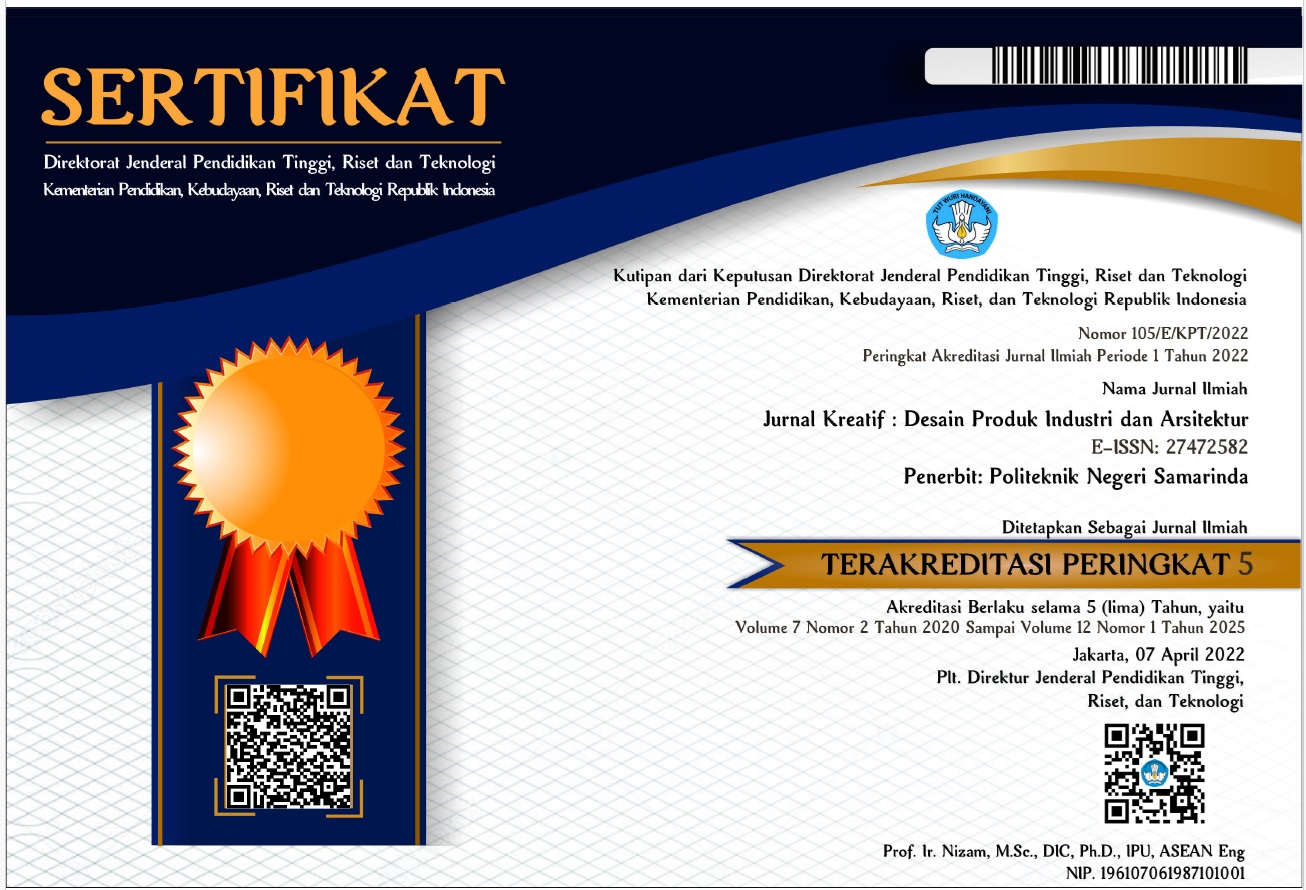PERANCANGAN BENCH MULTIFUNGSI BERGAYA JAPANDI
 Abstract views: 95
,
Abstract views: 95
,
 PDF downloads: 46
PDF downloads: 46
Abstract
Land limitations have increased the trend of limited housing development, based on this, it is necessary to choose the right furniture to support residential activities, one solution is to choose multifunctional furniture. Bench is furniture that is usually used only as a seat, in an era of high interest in multifunctional furniture and design trends that continue to grow, one of which is the Japandi style, a study was conducted that aims to create multifunctional Japandi furniture that combines Japanese minimalist aesthetics and Scandinavian practicality, so that it can optimize limited residential space. This study examines the elements of Japandi design which include the use of natural materials, neutral color palettes, and simple shapes. The multifunctional bench that was designed not only functions as a seat, but is also equipped with storage facilities to increase functionality without sacrificing aesthetic value. The research method uses a quantitative approach by involving respondents in filling out questionnaires, and using the design thinking design method which in its stages starts from empathize, define, ideate, prototype to test. Based on the data that has been processed, this product received a rating of 97.5% (very satisfied) both in terms of function and aesthetics.
Downloads
References
Anggarini, A., Agnes Natalia Bangun, D., Irpan Saripudin, Studi Desain Grafis, P., Teknik Grafika Penerbitan, J., & Negeri Jakarta, P. (2020). Alternatif Model Penyusunan Mood Board Sebagai Metode Berpikir Kreatif Dalam Pengembangan Konsep Visual. Journal Printing and Packaging Technology, 1, 1–7.
Etruly, N., & Yusuf, A. (2024). Perancangan Nakas Multifungsi Hidden Drawer dengan Mix Material. Jurnal Kreatif: Desain Produk Industri Dan Arsitektur, 12(2), 202–215. doi:https://doi.org/10.46964/jkdpia.v12i02.1069
Galih, M. C. W., Sulistyani, H., & Utomo, T. P. (2023). Gaya Japandi Sebagai Sumber Ide Perancangan Interior Day Spa Di Surabaya. Sanggitarupa, 3(1), 38–44. doi:https://doi.org/10.33153/sanggitarupa.v3i1.5226
Ganapathi, R., Omprakash, B., & Mohan, B. (2017). Design and Analysis of Convertible Bench. International Journal of Creative Research Thoughts, 5(4), 2320–2882. Retrieved from www.ijcrt.org
Kartika Dewi, S., Kurniawati Haryanto, E., & De Yong, S. (2018). Identifikasi Penerapan Design Thinking dalam Pembelajaran Perancangan. Paper presented at the Seminar Nasional Seni Dan Desain: “Konvergensi Keilmuan Seni Rupa Dan Desain Era 4.0,, Surabaya
Khoirul Musadid, A., Wibowo, D. D., & Zainudin, A. (2024). Perancangan Set Meja Makan Menggunakan Konsep Space Saving dengan Jerami Sebagai Unsur Hias. CandraRupa : Journal of Art, Design, and Media, 3(1), 1-9. doi:https://doi.org/10.37802/candrarupa.v3i1.537
KKBI. (2024). Kamus Besar Bahasa Indonesia (KBBI). Retrieved from https://kbbi.web.id
Melvin Dinata, C., Janus Anshory, B., & Wida Izzati, A. (2024). Interior Design with Japandi Concept at Tujuhari Coffee in South Jakarta. Journal of Scientech Research and Development, 6(1), 755–767.
Mojokerto, T. D., Kusumo, G. G., Suprobo, F. P., & Siwalankerto, J. (2017). Perancangan Mebel Multifungsi Untuk Villa Grand. JURNAL INTRA, 5(2), 769–776.
Nurmadina, Purwanto, A. A., & Gunawinata, A. (2023). Pembuatan Marquetry Pada Furnitur Dari Beberapa Jenis Kayu Di Indoensia. Jurnal Kreatif Jurnal Kreatif : Desain Produk Industri dan Arsitektur, 11(1), 57-62. doi:https://doi.org/10.46964/jkdpia.v11i1.357
Poetra, B. L. (2016). Perancangan Perabot Multifungsi untuk Ruang Huni Terbatas. JURNAL INTRA, 4(2), 793.
Prianka, D., Khotania, D., & Juniati, N. (2023). Karakteristik Japandi untuk Koleksi Citywear for Womenswear and Menswear. KELUWIH: Jurnal Sains dan Teknologi, 4(2), 81–86. doi:https://doi.org/10.24123/saintek.v4i2.5986
Putra Elim, R., & Athalia, G. (2019). Perancangan Bench Multifungsi Dengan Konsep Lontong Balap Yang Di Tempatkan Di Stasiun Gubeng Surabaya.
Sari, I. P., Kartina, A. H., Pratiwi, A. M., Oktariana, F., Nasrulloh, M. F., & Zain, S. A. (2020). Implementasi Metode Pendekatan Design Thinking dalam Pembuatan Aplikasi Jurnal Pendidikan Multimedia, 2(1), 45–55.
Scholus, J. E., Pranata, J., & Andriani, N. R. (2023). Study on the Effect of Sociocultural Aspects on Consumer Interest Purchasing Japandi (Japanese-Scandinavian) Household Goods in Indonesian Marke. Ilomata International Journal of Social Science, 4(4), 763–774. doi:https://doi.org/10.52728/ijss.v4i4.1030
Senjaya, A. J. (2018). Campuran ( Mixed Method ) Dalam Riset Sosial. Risalah. Jurnal Pendidikan Dan Studi Islam, 4(1), 103–118. doi:https://doi.org/10.5281/zenodo.3552026
Setiawan, A. P. (2021). Desain Minimalis Multifungsi. In Desain Minimalis Multifungsi. . Retrieved from http://repository.petra.ac.id/19305
Copyright (c) 2025 Friska Damayanti, Ade Setiawan

This work is licensed under a Creative Commons Attribution-ShareAlike 4.0 International License.
Authors who publish with this journal agree to the following terms:
- Copyright on any article is retained by the author(s).
- The author grants the journal, right of first publication with the work simultaneously licensed under a Creative Commons Attribution License that allows others to share the work with an acknowledgment of the work’s authorship and initial publication in this journal.
- Authors are able to enter into separate, additional contractual arrangements for the non-exclusive distribution of the journal’s published version of the work (e.g., post it to an institutional repository or publish it in a book), with an acknowledgment of its initial publication in this journal.
- Authors are permitted and encouraged to post their work online (e.g., in institutional repositories or on their website) prior to and during the submission process, as it can lead to productive exchanges, as well as earlier and greater citation of published work.
- The article and any associated published material is distributed under the Creative Commons Attribution-ShareAlike 4.0 International License













